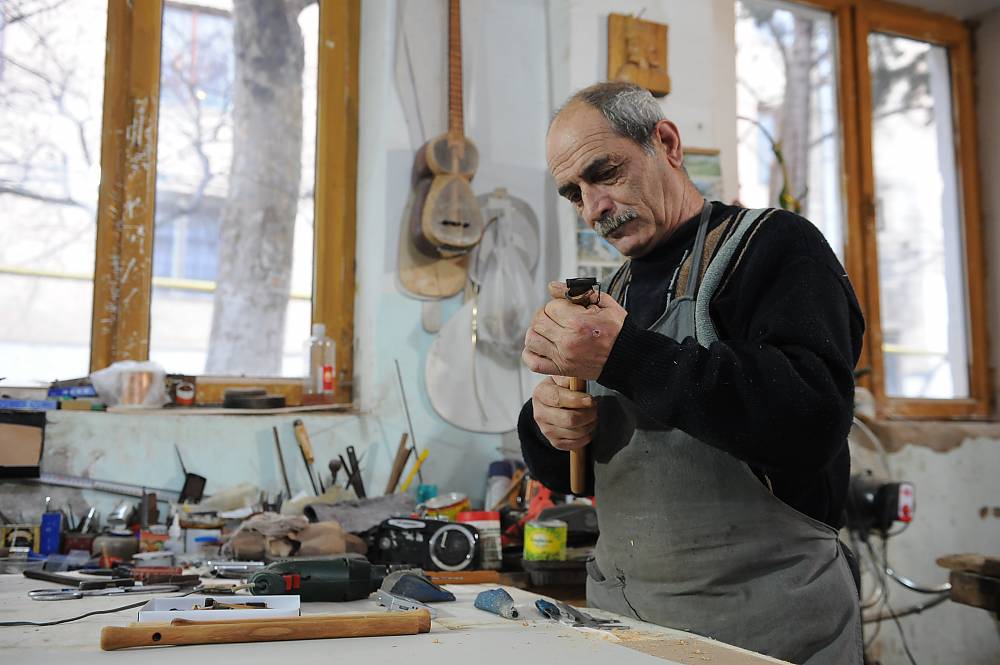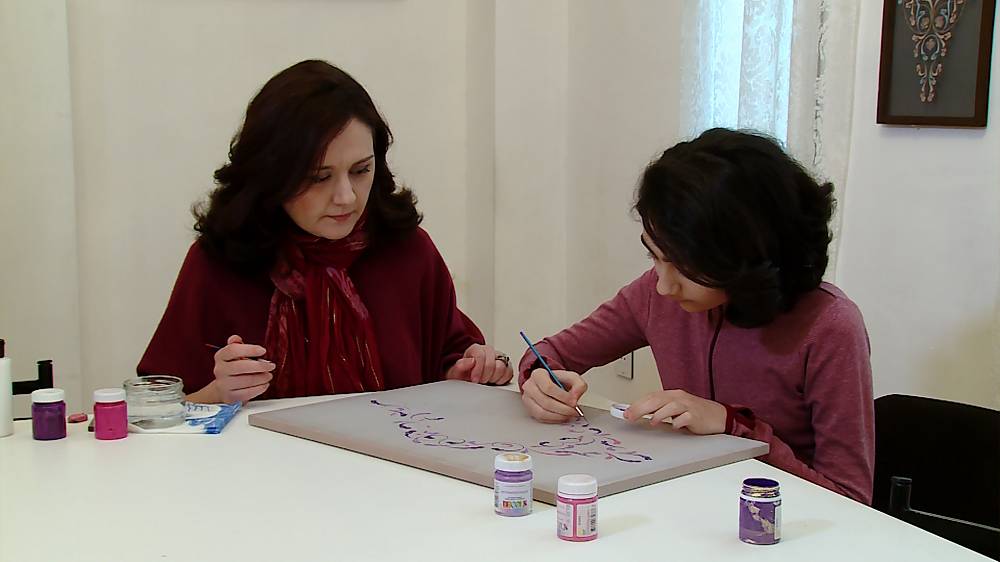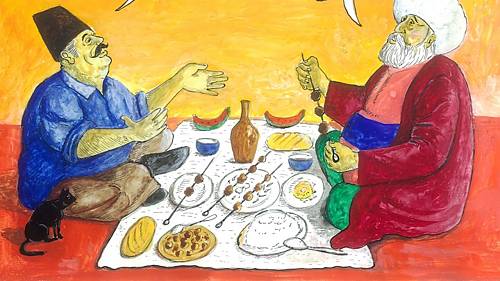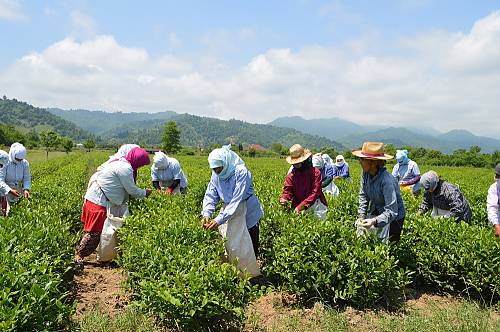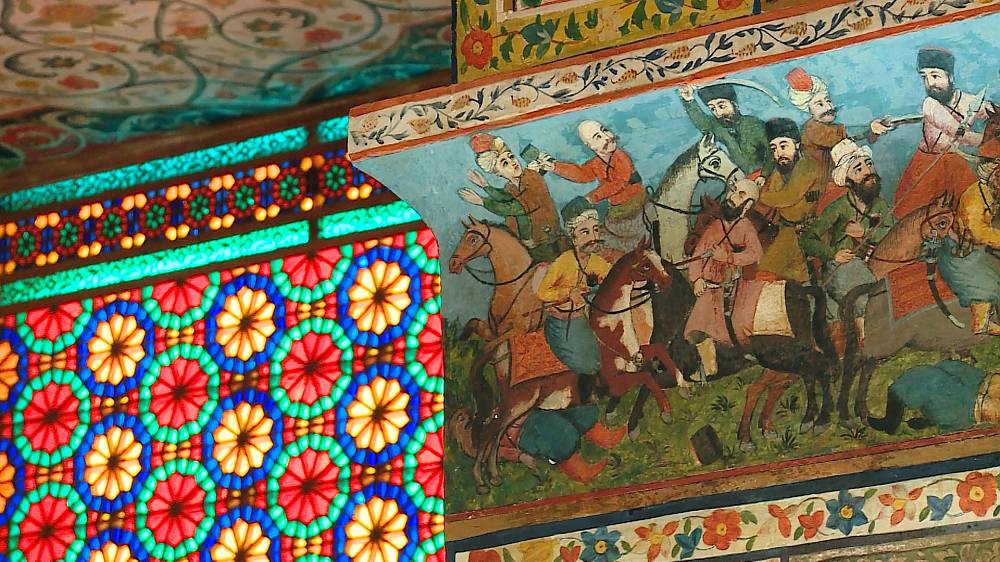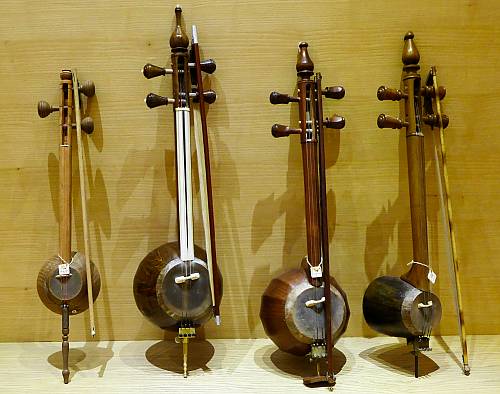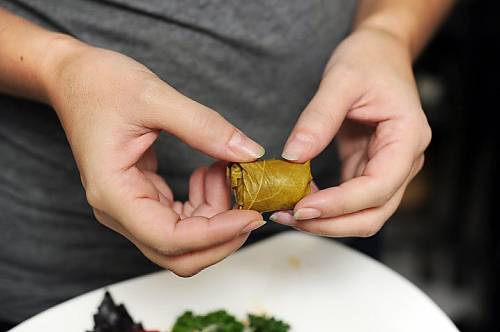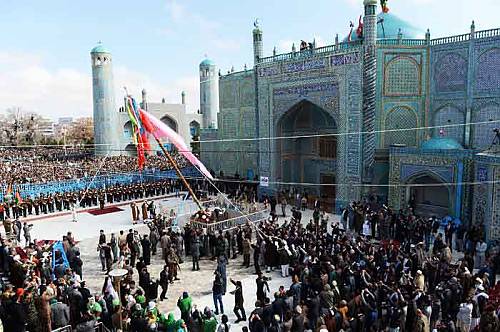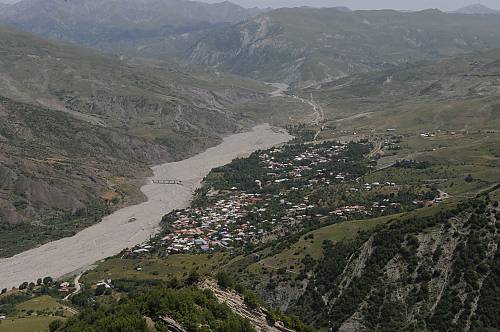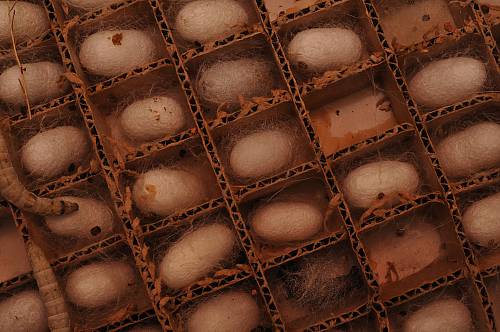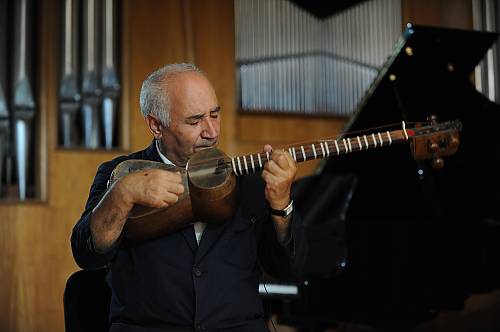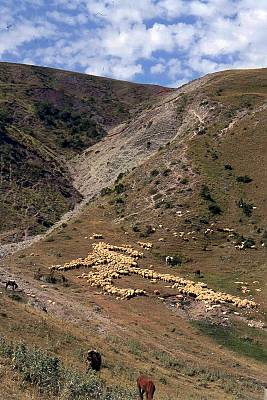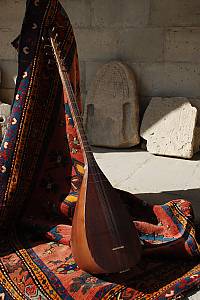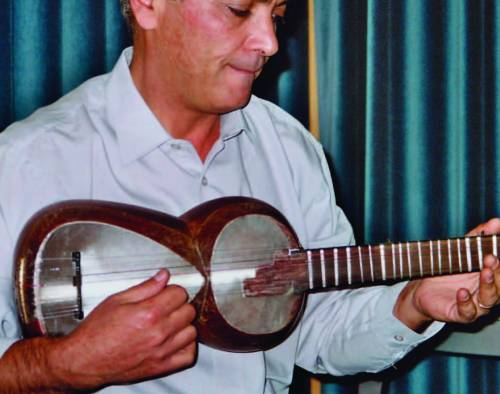Craftsmanship of mother of pearl inlay
Mother of pearl inlay is the practice of inserting mother of pearl pieces into wooden objects such as Koran cases, desks, chests, chairs, mirrors, jewel cases and musical instruments. Craftspeople begin by cutting the inner shells of molluscs into different shapes. They draw motifs on a piece of wood, carve out the outlines and shape the mother of pearl pieces, which are then inlaid to the wood. Finally, the surface is polished with sandpaper, burnt for colouring and varnished with melted resin. Practitioners use thick woods such as walnut, ebony and mahogany, preferring dark colours to contrast with the white of the mother of pearl. Geometrical, floral and calligraphic motifs are often used for embellishment. For craftspeople and their families, the element represents a part of daily life and is a source of identity and pride. It is transmitted through apprenticeships and in universities, public education centres and workshops. Today, craftspeople also share their knowledge and skills through social media and online blogs, forums and workshops, thus strengthening social cohesion and cultural exchange across different countries. They also contribute to the preservation of tangible heritage and of social and cultural memory by restoring historical objects exhibited in museums and monuments.
 Azerbaijan
Azerbaijan
Craftsmanship of mother of pearl inlay
multinational application of Azerbaijan and Türkiye
Date of Inscription:
Inscribed in 2023 (18.COM) on the Representative List of the Intangible Cultural Heritage of Humanity
Craftsmanship and performing art of balaban/mey
Balaban (in Azerbaijan) or Mey (in Türkiye) is a centuries-old woodwind instrument made up of three parts: a body, a wide and flat double reed and a clip. The instrument is traditionally made of plum or apricot wood and coated with linseed or olive oil. Once dry, crafters drill several holes into the front of the body and one hole into the back. The sizes, number of holes and materials used vary according to the region. The knowledge, skills and techniques of crafting and playing Balaban are typically passed on informally within families through observation and hands-on experience, as well as through apprenticeships. The musical practice is also transmitted formally in universities and high schools, traditional music conservatories, institutions and student music communities. Balaban plays a significant role in the music cultures of Azerbaijan and Türkiye and is commonly used as a solo or accompanying instrument at folk festivities, weddings and concerts. A vital part of the identity and collective memory of its musicians and craftspeople, it is also an important means of promoting cultural identity, solidarity and social memory in both countries, with people of all ages, genders, socio-economic backgrounds and ethnicities gathering to listen to and participate in the performances.
 Azerbaijan
Azerbaijan
Craftsmanship and performing art of balaban/mey
multinational application of Azerbaijan and Türkiye
Date of Inscription:
Inscribed in 2023 (18.COM) on the Representative List of the Intangible Cultural Heritage of Humanity
Iftar/Eftari/Iftar/Iftor and its socio-cultural traditions
Iftar (also called Eftari, İftar or Iftor in practicing countries) is observed by Muslims at sunset in the month of Ramadan (the ninth month in the lunar calendar), upon completion of all religious and ceremonial rites. Observed by people of all ages, genders and backgrounds, it marks the daily termination of the hardships of fasting from dawn to sunset. The evening prayer is followed by activities such as praying ceremonies, music, storytelling, games, preparing and serving traditional and local meals and marriage arrangements. For communities, it often takes the form of gatherings or meals, strengthening family and community ties and promoting charity, solidarity and social exchange. The ceremonies and rituals related to Iftar are also practised by people who do not necessarily fast during the month of Ramadan. The knowledge and skills are typically transmitted within families through oral instruction, observation and participation, and children and youth are often entrusted with preparing components of traditional meals. During this process, parents also transmit knowledge about the benefits of fasting and the social values and functions of Iftar. Iftar is often supported by governmental entities, NGOs and charities, as well as through television, radio, press and social media.
 Azerbaijan
Azerbaijan
Iftar/Eftari/Iftar/Iftor and its socio-cultural traditions
multinational application of Azerbaijan, Iran (Islamic Republic of), Türkiye , Uzbekistan
Date of Inscription:
Inscribed in 2023 (18.COM) on the Representative List of the Intangible Cultural Heritage of Humanity
Art of illumination: Təzhib/Tazhib/Zarhalkori/Tezhip/Naqqoshlik
Illumination is a centuries-old decorative art practised on the pages of manuscripts, calligraphic texts and miniatures. The main component is gold leaf or gold paint, both of which entail specific knowledge and techniques. Natural pigments are also used, and synthetic paints such as watercolour or gouache have become widespread in recent years. Today, traditional and contemporary interpretations of the element can be seen in manuscripts, miniatures and calligraphy as well as in stand-alone pieces of art. The practice is transmitted through apprenticeships as well as through formal and non-formal education, including in many universities, academies, research centres, and public and private workshops. The colours, patterns, and motifs used have symbolic meanings, and it is common to embellish religious texts, literary and historical manuscripts, marriage deeds and even commercial treaties with illuminations. The practice is therefore closely tied to the beliefs and cultural practices of communities. Illumination strengthens the sense of cultural continuity for communities at national, regional and international levels. And as the traditional knowledge and methods of illumination are also used in the restoration of ancient manuscripts and folios, the practice also contributes to the preservation of historical and cultural objects and to their safeguarding for future generations.
 Azerbaijan
Azerbaijan
Art of illumination: Təzhib/Tazhib/Zarhalkori/Tezhip/Naqqoshlik
multinational application of Azerbaijan, Iran (Islamic Republic of), Tajikistan, Türkiye , Uzbekistan
Date of Inscription:
Inscribed in 2023 (18.COM) on the Representative List of the Intangible Cultural Heritage of Humanity
Telling tradition of Nasreddin Hodja/ Molla Nesreddin/ Molla Ependi/ Apendi/ Afendi Kozhanasyr Anecdotes
The Telling Tradition of Nasreddin Anecdotes refers to the social practices and festivals around the telling of anecdotes attributed to Nasreddin, a philosopher and wiseman recognized for his wisdom and humorous analyses and representations of society and life experiences. Although there are slight differences across communities in terms of imagery, character names and stories, the key features are shared as a common heritage in Azerbaijan, Kazakhstan, Kyrgyzstan, Tajikistan, Türkiye, Turkmenistan and Uzbekistan. The anecdotes are transmitted through oral tradition and written sources and have inspired local idioms and proverbs. Many have become classics and are also distributed in printed and visual media and in television programmes prepared for children. Characterized by their wisdom, witty repartees, absurdity and element of surprise, the Nasreddin anecdotes often break with accepted norms, with the narrator finding unexpected ways out of complicated situations and always coming out as the winner by the power of word. The anecdotes have an instructive and entertaining function, and communities use them to enrich conversations, reinforce arguments, persuade others or explain a situation. Municipalities, universities and non-governmental organizations play a vital role in the transmission of the anecdotes, organizing various activities and festivals for their commemoration at local, national and international levels.
 Azerbaijan
Azerbaijan
multinational application of Azerbaijan, Kazakhstan, Kyrgyzstan, Tajikistan, Türkiye, Turkmenistan , Uzbekistan
Date of Inscription:
Inscribed in 2022 (17.COM) on the Representative List of the Intangible Cultural Heritage of Humanity
Sericulture and traditional production of silk for weaving
In sericulture and the traditional production of silk for weaving, farmers care for the silkworms through their entire lifecycle, growing the mulberry trees that provide leaves upon which the worms feed and produce silkworm eggs. The fibres are reeled from the cocoons, spun into silk threads, cleaned and dyed. The threads are then used to create various types of craft products, including fabrics, carpets, rugs and curtains. Silk products are highly valued by all social and cultural classes, and people use them for special occasions such as weddings, funerals and family gatherings. Deeply rooted in the traditions of the Great Silk Road, the practice is an expression of cultural identity and centuries-old traditions. It is also viewed as a symbol of social cohesion, as the silk trade contributed to the exchange of culture and science within and across the countries concerned.
 Azerbaijan
Azerbaijan
Sericulture and traditional production of silk for weaving
multinational application of Afghanistan, Azerbaijan, Iran (Islamic Republic of), Tajikistan, Türkiye, Turkmenistan , Uzbekistan
Date of Inscription:
Inscribed in 2022 (17.COM) on the Representative List of the Intangible Cultural Heritage of Humanity
Pehlevanliq culture: traditional zorkhana games, sports and wrestling
Pehlevanliq culture in Azerbaijan includes games and sports, such as wrestling, and individual performances. Pehlevans use specific tools that resemble medieval weapons (such as swords, shields and bows), but are heavier (originally, to allow pehlevans to handle real weapons easily). The competitions are overseen by referees and accompanied by music or fast-beating drums. The main practitioners of the element are the pehlevans, the men who practise, perform and transmit their knowledge and skills. The community also includes local organizations, trainers and students at local physical education institutions, as well as the spectators and the craftsmen who create the tools. The main driver for the transmission of the element has been the interest of local communities in the games, sports and performances. An integral part of popular culture, folk events and outdoor celebrations, Pehlevanliq culture provides a strong sense of identity to communities in Azerbaijan. For many years, pehlevans have been a symbol of determination, promoting social cohesion and providing a sense of pride and shared identity to local communities.
 Azerbaijan
Azerbaijan
Pehlevanliq culture: traditional zorkhana games, sports and wrestling
Date of Inscription:
Inscribed in 2022 (17.COM) on the Representative List of the Intangible Cultural Heritage of Humanity
Culture of Çay (tea), a symbol of identity, hospitality and social interaction
Tea culture in Azerbaijan and Türkiye is an important social practice that shows hospitality, builds and maintains social ties, and is used to celebrate important moments in the lives of communities. Although there are several types of tea and brewing techniques, communities in both countries primarily harvest and consume black tea. Communities brew tea by using a wide variety of kettles, produced using traditional craftsmanship. The drink is served freshly-brewed and hot, in pear-shaped cups made from glass, porcelain, faience or silver. It is typically accompanied by sweets, sugar, lemon slices, jams and dried fruits. In certain regions of Azerbaijan, some communities also add local spices and herbs to the tea, such as cinnamon, ginger and thyme. Tea culture is an essential part of daily life for all layers of society, providing a strong sense of cultural identity. The bearers include tea farmers and harvesters, tearoom owners, tea makers, and the artisans who make the associated tools, utensils and sweets.
 Azerbaijan
Azerbaijan
Culture of Çay (tea), a symbol of identity, hospitality and social interaction
multinational application of Azerbaijan and Türkiye
Date of Inscription:
Inscribed in 2022 (17.COM) on the Representative List of the Intangible Cultural Heritage of Humanity
Art of miniature
The miniature is a type of two-dimensional artwork that involves the design and creation of small paintings on books, papier-mâché, rugs, textiles, walls, ceramics and other items using raw materials such as gold, silver and various organic substances. Historically, the miniature was exemplified by book painting in which the text was supported visually, but the element has evolved and can also be observed in architecture and as an adornment in public spaces. The patterns of the miniature represent beliefs, worldviews and lifestyles in a pictorial fashion and also gained a new character through the Islamic influence. While there are stylistic differences between them, the art of miniature as practiced by the submitting States Parties shares crucial features. In all cases, it is a traditional craft typically transmitted through mentor-apprentice relationships (non-formal education) and considered as an integral part of each society’s social and cultural identity. The miniature displays a specific type of perspective in which the size of the figures changes according to their importance – a key difference from realistic and naturalistic styles. Though it has existed for centuries, it continues to develop and thus strengthens the bonds between past and present. Traditional painting principles and techniques are preserved, but artists also bring individual creativity into the process.
 Azerbaijan
Azerbaijan
multinational application of Azerbaijan, Iran (Islamic Republic of , Türkiye, Uzbekistan
Date of Inscription:
Inscribed in 2020 (15.COM) on the Representative List of the Intangible Cultural Heritage of Humanity
Nar Bayrami, traditional pomegranate festivity and culture
Nar Bayrami is an annual festival in October/November in Azerbaijan’s Goychay region that celebrates the pomegranate and its traditional uses and symbolic meaning. Pomegranate culture is a set of practices, knowledge, traditions and skills related to the cultivation of the fruit, which is used not only in a range of culinary contexts, but is also referred to in crafts, decorative arts, myths, storytelling and other creative outlets. The element is linked to local agriculture and to the farmers and individuals in rural communities that grow and collect the fruit. These participants have an understanding of environmental characteristics and harvesting techniques. The fruit enjoys great visibility in society as both the pomegranate and Nar Bayrami perform a range of cultural and social functions – everything from its use in traditional meals to being cited in poetry. Symbolically, the pomegranate is associated with long-term productivity, abundance and is considered as a carrier of energy. Azerbaijani Local legends viewed it as a symbol of love and passion, while religious people saw it as symbolizing eternity. The annual celebration displays pride for centuries-old traditionsthis festivity and culture related to the fruit and encourages active exchange and communication among communities and visitors to the festivity, a time to highlight local nature and culture.
 Azerbaijan
Azerbaijan
Nar Bayrami, traditional pomegranate festivity and culture
Date of Inscription:
Inscribed in 2020 (15.COM) on the Representative List of the Intangible Cultural Heritage of Humanity
Heritage of Dede Qorqud/Korkyt Ata/Dede Korkut, epic culture, folk tales and music
The epic culture, folk tales and music of Dede Qorqud/Korkyt Ata/Dede Korkut are based on twelve heroic legends, stories and tales and thirteen traditional musical compositions shared and transmitted across the generations through oral expressions, performing arts, cultural codes and musical compositions. Dede Qorqud appears in each story as a legendary figure and wise individual, a sage of minstrels whose words, music and expressions of wisdom relate to traditions of birth, marriage and death. In the musical compositions, the main intonations are reproduced using a musical instrument called the Kobyz through the sounds of nature, and imitation soundscapes are characteristic of this medium (such as the imitation of a wolf’s howl or a swan’s note). The musical compositions are all interconnected by the epic stories that accompany them. The element encompasses social, cultural and moral values such as heroism, dialogue, physical and spiritual wellness and unity as well as respect for nature, and contains profound knowledge about the history and culture of Turkic-speaking communities. It is practised and sustained by the community concerned on a wide variety of occasions – from family events to national and international festivals – and is therefore well-rooted in society, serving as a connecting thread between generations.
 Azerbaijan
Azerbaijan
Heritage of Dede Qorqud/Korkyt Ata/Dede Korkut, epic culture, folk tales and music
multinational application of Azerbaijan, Kazakhstan, Türkiye
Date of Inscription:
Inscribed in 2018 (13.COM) on the Representative List of the Intangible Cultural Heritage of Humanity
Yalli (Kochari, Tenzere), traditional group dances of Nakhchivan
Yalli, traditional group dances, are dance expressions based exclusively on collective performances. Typically, yalli are performed in a circle, chain or line, and involve elements of games, pantomime (bird or other animal imitations), physical exercises and movements. The community of the yalli dances consists of practising dancers, who enact the dances either spontaneously or in a planned manner at various festivities and celebrations. Some variants of yalli bear a song-like character and are practised by both women and men, while others are practised by men only and imitate pastoralist games with some elements of butting animals. Until the mid-twentieth century, yalli were widely practised but several factors have impacted the transmission of the practice thereafter. They include a gradual loss of social functions for certain types of yalli, a preference for staged performances, external factors such as labour migration and the economic crises of the late 1980s and early 1990s, a shift from informal to formal transmission, and a drastic simplification of the dances, which has entailed a loss of diversity.
 Azerbaijan
Azerbaijan
Yalli (Kochari, Tenzere), traditional group dances of Nakhchivan
Date of Inscription:
Inscribed in 2018 (13.COM) on the List of Intangible Cultural Heritage in Need of Urgent Safeguarding
Art of crafting and playing with Kamantcheh/Kamancha, a bowed string musical instrument
The art of crafting and playing with Kamantcheh/Kamancha (‘little bow’), a bowed string instrument, has existed for over 1,000 years. In the Islamic Republic of Iran and Azerbaijan, it constitutes a major element of classical and folkloric music, and performances occupy a central place in a wide number of social and cultural gatherings. Contemporary practitioners mainly use a four-stringed Kamantcheh/Kamancha comprising a body and bow made with horsehair and players perform either individually or as part of orchestras. Bearers and practitioners consist of craftspeople, amateur or professional players, and teachers and students of the element. Kamantcheh/Kamancha is an essential part of musical culture in both countries, and while crafting the instrument represents a direct source of earning a living, craftspeople also perceive the art as a strong part of the intangible cultural heritage of their communities. Through their music, performers convey many themes, from the mythological to the gnostic and the comic. Today, knowledge of performing and crafting Kamantcheh/Kamancha is transmitted both within families and in State-sponsored musical institutions and schools. Knowledge about the importance of the music in promoting cultural identity is transmitted from generation to generation in all strata of society in both countries.
 Azerbaijan
Azerbaijan
Art of crafting and playing with Kamantcheh/Kamancha, a bowed string musical instrument
multinational application of Azerbaijan and Iran (Islamic Republic)
Date of Inscription:
Inscribed in 2017 (12.COM) on the Representative List of the Intangible Cultural Heritage of Humanity
Dolma making and sharing tradition, a marker of cultural identity
Dolma tradition is a set of knowledge and skills relating to the preparation of the traditional meal ‘dolma’, which takes the form of small fillings (containing meat, onion, rice, peas and spices) wrapped in fresh or pre-cooked leaves or stuffed in fruits and vegetables. The name of the tradition originates from the shortened Turkic word ‘doldurma’, meaning ‘stuffed’. The meal is shared within families or local communities, with different methods, techniques and ingredients used to prepare the traditional meal by different communities. The tradition is present throughout the Republic of Azerbaijan, and is perceived as a central culinary practice in all regions. It is enjoyed on special occasions and gatherings and expresses solidarity, respect and hospitality. It is transmitted from generation to generation and transcends ethnic and religious boundaries within the country. Bearers consist of traditional cooking practitioners, mostly women, and the wider community of people that use dolma for various cultural and social purposes. The tradition is transmitted through parent-child relationships, while formal transmission mainly occurs in vocational and apprenticeship schools. The element enjoys great visibility within Azerbaijani society, and its viability is ensured by the communities through numerous awareness-raising activities and events such as festivals, vocational schools that teach the tradition and the preparation of publications on the subject.
 Azerbaijan
Azerbaijan
Dolma making and sharing tradition, a marker of cultural identity
Date of Inscription:
Inscribed in 2017 (12.COM) on the Representative List of the Intangible Cultural Heritage of Humanity
Nawrouz, Novruz, Nowrouz, Nowrouz, Nawrouz, Nauryz, Nooruz, Nowruz, Navruz, Nevruz, Nowruz, Navruz
New Year is often a time when people wish for prosperity and new beginnings. March 21 marks the start of the year in Afghanistan, Azerbaijan, India, Iran (Islamic Republic of), Iraq, Kazakhstan, Kyrgyzstan, Pakistan, Tajikistan, Türkiye, Turkmenistan and Uzbekistan. It is referred to as Nauryz, Navruz, Nawrouz, Nevruz, Nooruz, Novruz, Nowrouz or Nowruz meaning ‘new day’ when a variety of rituals, ceremonies and other cultural events take place for a period of about two weeks. An important tradition practised during this time is the gathering around ‘the Table’, decorated with objects that symbolize purity, brightness, livelihood and wealth, to enjoy a special meal with loved ones. New clothes are worn and visits made to relatives, particularly the elderly and neighbours. Gifts are exchanged, especially for children, featuring objects made by artisans. There are also street performances of music and dance, public rituals involving water and fire, traditional sports and the making of handicrafts. These practices support cultural diversity and tolerance and contribute to building community solidarity and peace. They are transmitted from older to younger generations through observation and participation.
 Azerbaijan
Azerbaijan
Nawrouz, Novruz, Nowrouz, Nowrouz, Nawrouz, Nauryz, Nooruz, Nowruz, Navruz, Nevruz, Nowruz, Navruz
multinational application of Azerbaijan, India, Iran (Islamic Republic of), Iraq, Kazakhstan, Kyrgyzstan, Pakistan, Tajikistan, Türkiye, Turkmenistan , Uzbekistan
Date of Inscription:
Inscribed in 2016 (11.COM) on the Representative List of the Intangible Cultural Heritage of Humanity
Flatbread making and sharing culture: Lavash, Katyrma, Jupka, Yufka
The culture of making and sharing flatbread in communities of Azerbaijan, Iran, Kazakhstan, Kyrgyzstan and Türkiye carries social functions that have enabled it to continue as a widely-practised tradition. Making the bread (lavash, katyrma, jupka or yufka) involves at least three people, often family members, with each having a role in its preparation and baking. In rural areas, neighbours participate in the process together. Traditional bakeries also make the bread. It is baked using a tandyr/tanūr (an earth or stone oven in the ground), sāj (a metal plate) or kazan (a cauldron). Besides regular meals, flatbread is shared at weddings, births, funerals, various holidays and during prayers. In Azerbaijan and Iran, it is put on the bride’s shoulders or crumbled over her head to wish the couple prosperity while in Türkiye it is given to the couple’s neighbours. At funerals in Kazakhstan it is believed the bread should be prepared to protect the deceased while a decision is made from God and in Kyrgyzstan sharing the bread provides a better afterlife for the deceased. The practice, transmitted by participation within families and from master to apprentice, expresses hospitality, solidarity and certain beliefs that symbolize common cultural roots reinforcing community belonging.
 Azerbaijan
Azerbaijan
Flatbread making and sharing culture: Lavash, Katyrma, Jupka, Yufka
multinational application of Azerbaijan, Iran (Islamic Republic of), Kazakhstan, Kyrgyzstan, Türkiye
Date of Inscription:
Inscribed in 2016 (11.COM) on the Representative List of the Intangible Cultural Heritage of Humanity
Copper craftsmanship of Lahij
Copper craftsmanship of Lahij is the traditional practice of making and using copperware concentrated in the Lahij community in the Caucasus. The copper-smelting master coordinates the entire process and is accompanied by an apprentice who learns the necessary techniques while helping the master. The coppersmith-hammerer pumps the air into the ovens and hammers the smelted copper into thin plates. A craftsperson then polishes the hammered copper plates and decorates the ready copperware with engravings. This final stage of the process is said to be particularly important as the designs used often have an environmental focus, reflecting the bearer’s traditional knowledge and cultural values. The master is responsible for selling the copperware in the workshops and remunerating the work of the other craftspeople involved. The tradition is transmitted within families from father to son. Numerous families in Azerbaijan come to buy copperware in Lahij and use it in their daily lives believing it improves the health benefits of food. For artisans, the tradition represents a major source of living and provides a strong sense of identity and community pride. Copper craftsmanship also reinforces family relationships within the Lahij community and is perceived as a clear marker of Lahij identity.
 Azerbaijan
Azerbaijan
Date of Inscription:
Inscribed in 2015 (10.COM) on the Representative List of the Intangible Cultural Heritage of Humanity
Traditional art and symbolism of Kelaghayi, making and wearing women’s silk headscarves
Rooted in traditions found along the Great Silk Road, the art of Kelaghayi is concentrated in two locations in the Republic of Azerbaijan: the city of Sheki and the Basgal settlement. Kelaghayi making consists of several stages: fabric weaving, dyeing and woodblock decoration. Weavers choose thin silk threads from sericulture producers and weave fabrics on looms and then boil and dry them to make square-shaped cloths. Using vegetable substances, masters then dye the cloths various colours and decorate them with patterns using wooden stamps, covered with solutions made from rosin, paraffin and solid oil. The colours of headscarves have symbolic meanings and are often tied to specific social occasions, such as weddings, mourning ceremonies, daily activities and celebrations. The art of Kelaghayi making is transmitted through non-formal apprenticeship only, and is primarily a family occupation. Each family has its own stylistic features and patterns of decoration. The traditional practice of making and wearing headscarves is an expression of cultural identity and religious traditions and a symbol of social cohesion, reinforcing the role of women and strengthening the cultural unity of Azerbaijani society.
 Azerbaijan
Azerbaijan
Traditional art and symbolism of Kelaghayi, making and wearing women’s silk headscarves
Date of Inscription:
Inscribed in 2014 (9.COM) on the Representative List of the Intangible Cultural Heritage of Humanity
Chovqan, a traditional Karabakh horse-riding game in the Republic of Azerbaijan
Chovqan is a traditional horse-riding game played on a flat, grassy field by two competing teams of players mounted on Karabakh horses. Each team has five riders, with two fullbacks and three forwards. The game starts at the centre of the field and players use wooden mallets to try to drive a small leather or wooden ball into their opponents’ goal. The game is interspersed with instrumental folk music called janghi. Chovqan players and trainers are all local male farmers and skilled riders. They traditionally wear large astrakhan hats, long tight-fitting coats with a high waist, and special trousers, socks and shoes. People of all ages come to watch this traditional game and to support their teams. Chovqan strengthens feelings of identity rooted in nomadic culture and linked to the perception of the horse as an integral part of everyday life. The specific rules, skills and techniques of Chovqan are transmitted from experienced players to beginners through collective training. The practice and transmission of Chovqan have weakened, however, due to a loss of interest among the youth, combined with urbanization and migration, leading to a shortage of players, trainers and Karabakh horses.
 Azerbaijan
Azerbaijan
Chovqan, a traditional Karabakh horse-riding game in the Republic of Azerbaijan
Date of Inscription:
Inscribed in 2013 (8.COM) on the List of Intangible Cultural Heritage in Need of Urgent Safeguarding
Craftsmanship and performance art of the Tar, a long-necked string musical instrument
The Tar is a long-necked plucked lute, traditionally crafted and performed in communities throughout Azerbaijan. Considered by many to be the country’s leading musical instrument, it features alone or with other instruments in numerous traditional musical styles. Tar makers transmit their skills to apprentices, often within the family. Craftsmanship begins with careful selection of materials for the instrument: mulberry wood for the body, nut wood for the neck, and pear wood for the tuning pegs. Using various tools, crafters create a hollow body in the form of a figure eight, which is then covered with the thin pericardium of an ox. The fretted neck is affixed, metal strings are added and the body is inlaid with mother-of-pearl. Performers hold the instrument horizontally against the chest and pluck the strings with a plectrum, while using trills and a variety of techniques and strokes to add colour. Tar performance has an essential place in weddings and different social gatherings, festive events and public concerts. Players transmit their skills to young people within their community by word of mouth and demonstration, and at educational musical institutions. Craftsmanship and performance of the tar and the skills related to this tradition play a significant role in shaping the cultural identity of Azerbaijanis.
 Azerbaijan
Azerbaijan
Craftsmanship and performance art of the Tar, a long-necked string musical instrument
Date of Inscription:
Inscribed in 2012 (7.COM) on the Representative List of the Intangible Cultural Heritage of Humanity
Traditional art of Azerbaijani carpet weaving in the Republic of Azerbaijan
The Azerbaijani carpet is a traditional handmade textile of various sizes, with dense texture and a pile or pile-less surface, whose patterns are characteristic of Azerbaijan’s many carpet-making regions. Carpet making is a family tradition transferred orally and through practice. Men shear sheep in spring and autumn, while women collect dyestuffs and spin and dye yarn in the spring, summer and autumn. The weaving is undertaken during winter by the female members of the extended family, girls learning from their mothers and grandmothers and wives assisting their mothers-in-law. The carpet is made on horizontal or vertical looms using multi-coloured wool, cotton or silk yarn coloured with natural dyes. Applying special techniques to create pile carpets, weavers knot the pile yarn around threads of the warp; pile-less carpets are variously made with interlacing structural warps, wefts, and patterning wefts. The cutting of a finished carpet from the loom is an unusually solemn celebration. Carpet weaving is closely connected with the daily life and customs of the communities involved, its role reflected in the meaning of the designs and their applications. Thus, girls seated on carpets tell fortunes and sing traditional songs at Novruz (the regional New Year). The carpet is widely used for home furniture and decoration, and special carpets are woven for medical treatment, for wedding ceremonies, the birth of a child, mourning rituals and prayer.
 Azerbaijan
Azerbaijan
Traditional art of Azerbaijani carpet weaving in the Republic of Azerbaijan
Date of Inscription:
Inscribed in 2010 (5.COM) on the Representative List of the Intangible Cultural Heritage of Humanity
Art of Azerbaijani Ashiq
The art of Azerbaijani Ashiqs combines poetry, storytelling, dance and vocal and instrumental music into a traditional performance art that stands as a symbol of Azerbaijani culture. Characterized by the accompaniment of the saz, a stringed musical instrument, the classical repertoire includes 200 songs, 150 literary-musical compositions known as dastans, nearly 2,000 poems in different traditional poetic forms and numerous stories. The regional variations may include other musical instruments, but all are united by a common national language and artistic history. Ashiqs take part in weddings, friendly parties and festive events throughout the Caucasus and appear on concert stages, radio and television, sometimes synthesizing classical melodies with contemporary ones as they continue to recreate their repertoire. Their art is considered an emblem of national identity and the guardian of Azerbaijani language, literature and music. Even as Ashiqs represent the consciousness of a people, they also help to promote cultural exchange and dialogue: Kurds, Lezhins, Talishes, Tats and other ethnic groups living in the country often perform the Ashiqs’ art, and their poems and songs have spread across the region.
 Azerbaijan
Azerbaijan
Date of Inscription:
Inscribed in 2009 (4.COM) on the Representative List of the Intangible Cultural Heritage of Humanity
Azerbaijani Mugham
The art of Azerbaijani Ashiqs combines poetry, storytelling, dance and vocal and instrumental music into a traditional performance art that stands as a symbol of Azerbaijani culture. Characterized by the accompaniment of the saz, a stringed musical instrument, the classical repertoire includes 200 songs, 150 literary-musical compositions known as dastans, nearly 2,000 poems in different traditional poetic forms and numerous stories. The regional variations may include other musical instruments, but all are united by a common national language and artistic history. Ashiqs take part in weddings, friendly parties and festive events throughout the Caucasus and appear on concert stages, radio and television, sometimes synthesizing classical melodies with contemporary ones as they continue to recreate their repertoire. Their art is considered an emblem of national identity and the guardian of Azerbaijani language, literature and music. Even as Ashiqs represent the consciousness of a people, they also help to promote cultural exchange and dialogue: Kurds, Lezhins, Talishes, Tats and other ethnic groups living in the country often perform the Ashiqs’ art, and their poems and songs have spread across the region.
 Azerbaijan
Azerbaijan
Date of Inscription:
Inscribed in 2008 (3.COM) on the Representative List of the Intangible Cultural Heritage of Humanity (originally proclaimed in 2003)


